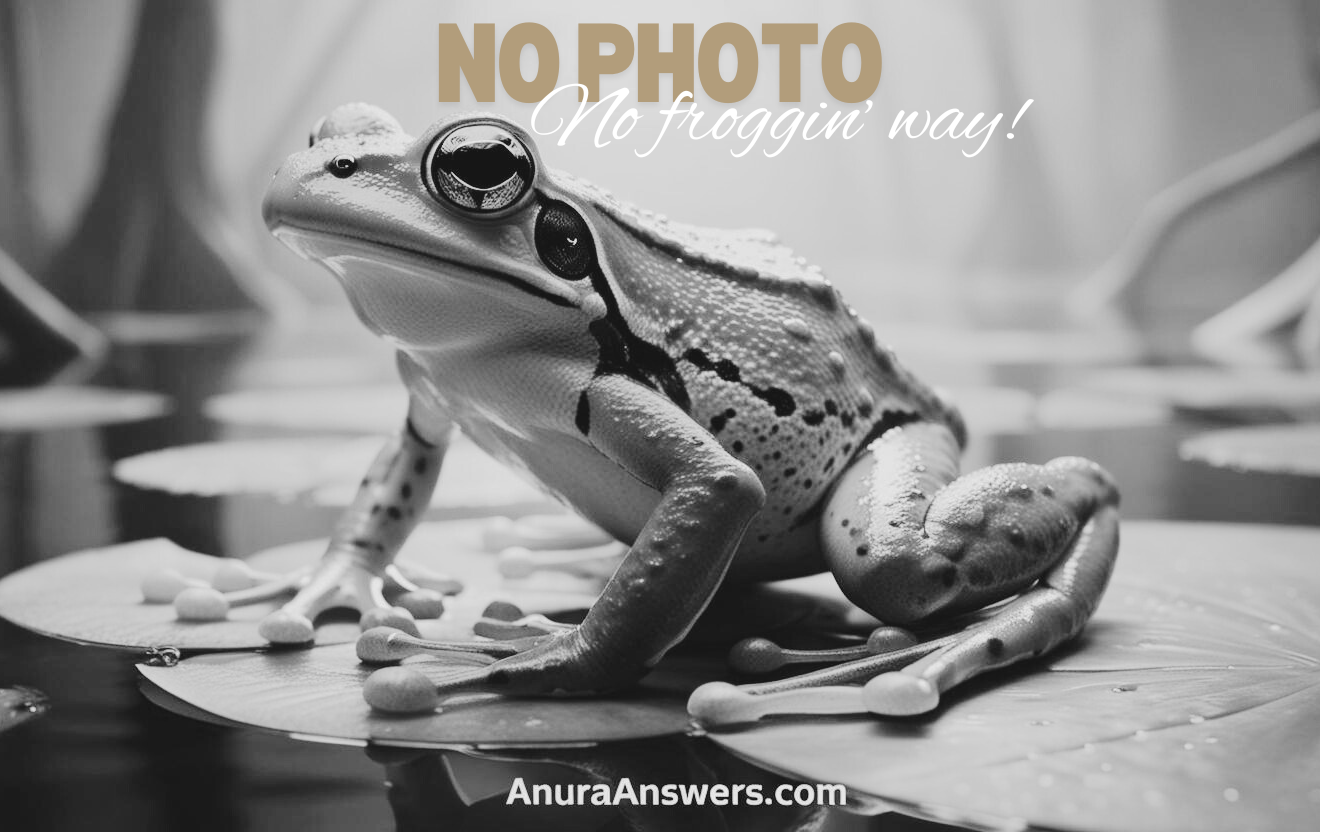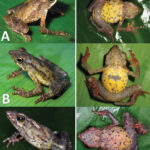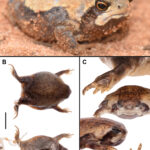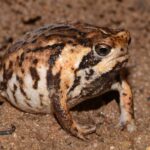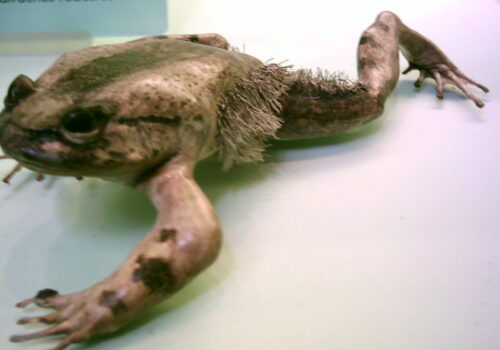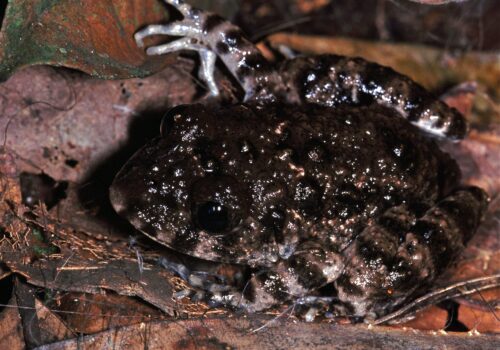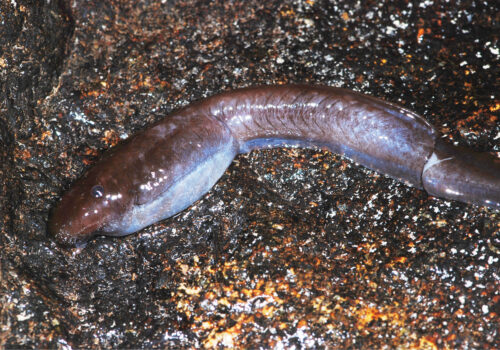Crimson-Bellied Leaf Litter Frog: Exploring the Secret World of Arthroleptis hematogaster#
Hidden beneath dense foliage, invisible to most casual observers, lies a small, enigmatic amphibian whose vibrant presence is known more through scientific texts than personal encounters. The Crimson-Bellied Leaf Litter Frog, scientifically named Arthroleptis hematogaster, reveals itself gently—darting gracefully amid the leaf litter, softly calling amid twilight shadows, subtly weaving into the very fabric of its rainforest home. Few people beyond biologists and ardent nature enthusiasts may recognize its name, but this diminutive frog plays an outsized role in the ecological balance of its forest habitat, all while maintaining a secretive natural elegance.
Named aptly from the Greek arthron, meaning joint, and leptos, meaning delicate or thin, Arthroleptis literally evokes a sense of refinement. Meanwhile, hematogaster references the striking crimson-red undersides, making it one of Africa’s forest-floor hidden gems. In the rainy labyrinthine canopy shadows of Central and West Africa, it silently thrives and reminds us of nature’s intricate, interconnected designs.
Taxonomy and Classification#
The Crimson-Bellied Leaf Litter Frog is classified within the Arthroleptidae family, an intriguing group of frogs known colloquially as squeaker frogs, owing to their characteristically gentle, squeaking mating calls. Their unique calls—a whisper against the forest’s robust cacophony—are an evolutionary celebration of subtle communication. The genus Arthroleptis encompasses numerous terrestrial African frogs, known for their direct development—remarkably skipping aquatic tadpole stages and emerging directly from eggs as miniature versions of their parents.
Arthroleptis hematogaster is particularly special within this genus, identified by its unique coloring and subtle morphological traits. Taxonomists initially described this species in the early 20th century, assigning it to the genus based on features like specialized toes, distinctive vocalizations, and morphological skeletal adaptations ideal for life within damp forest litter, a challenging habitat calling for exceptional evolutionary finesse.
Natural Habitat#
Exploring the secluded terrains where Arthroleptis hematogaster gallivants reveals a world delicately balanced between moisture and earthy solidity. Native predominantly to tropical forests of West and Central Africa, including portions of Cameroon, Equatorial Guinea, Gabon, and Nigeria, this elusive frog seeks sanctuary beneath vibrant leaf litter and forest debris. Here amid bursts of sunlight filtering through lush overhead foliage, life persists with slow, deliberate intent.
The rainforest floor, often teeming with moss-lined roots and rugged detritus fostered by humid conditions, offers A. hematogaster prime real estate. Through generations of subtle adaptation, this amphibian has mastered thriving in this moisture-rich, nutrient-saturated microcosm. The humid understory creates a living nursery for arthropods—perfect prey for the Crimson-bellied Leaf Litter Frog.
In these shadowy microhabitats, delicately balanced between decay and renewal, this expert hider has honed survival mechanisms. Its practical invisibility not only reduces predation risk but also allows it ample opportunities to feast unseen amidst this ecosystem’s abundance, perfectly tailored to its modestly secretive lifestyle beneath the wet tropical greenery.
Physical Characteristics#
At a mere 25 to 35 millimeters in length, the Crimson-Bellied Leaf Litter Frog exemplifies nature’s extraordinary gifts packed into small packages. From above, their appearance is carefully subdued, cloaked in camouflage-colored shades of brown or muted grey, punctuated by delicate, irregular mottlings of darker pigment. But the true spectacle lies beneath—a vibrant scarlet belly so brilliant that it immediately arrests the observer’s eye. This color, hidden except during rare tactile interactions, remains primarily concealed against predation but broadcast loudly during necessary moments, such as during mating displays or defensive behaviors.
Their small limbs radiate agility, affording them exceptional maneuverability. Delicate feet pad softly against decomposing leaves, scarcely audible in the quietest moments, perfectly adapted for stealthy hunting of insects and small arthropods. Large, inviting eyes peer upwards, capturing hints of shadowy motion above, always alert to the slightest rustle that signifies a potential threat or opportunity.
Evolved over thousands of generations, subtle physical adaptations like tougher skin resistant to dampness, specialized digits suited for navigating slippery surfaces, and acute eyesight capable of rapid reflex responses illustrate a life closely intertwined with the forest floor’s unique challenges and rewards.
Behavior and Life Cycle#
Silent Predators in Leafy Shadows#
Life beneath the rainforest canopy might appear unassuming, yet the daily behaviors of A. hematogaster unveil natural ambition and ingenious survival strategies. With precisely calibrated patience, these frogs practice “sit-and-wait” predation. Camouflaged elegantly amid decaying debris, they rely on stealth and speed, seizing passing prey swiftly and silently. Beetles, ants, termites, and smaller invertebrates provide a crucial diet, consumed deftly amid humid twilight.
Unique Breeding — Direct Development#
While many amphibians depend on aquatic habitats for reproduction, the Crimson-Bellied Leaf Litter Frog follows a different biological blueprint—direct development. Females deposit small, clustered eggs into moist soil layers or leaf litter rather than submerged aquatic spaces. Here, in humid safety, the eggs undergo complete embryonic development, foregoing the traditional, perilous larval aquatic life stage entirely. Remarkably, hatchlings essentially emerge as tiny replicas of adult frogs, ready to traverse their miniature world immediately.
The Gentlest Chorus#
During rainy seasons, as twilight casts dim shadows and droplets echo upon leaves, male A. hematogaster issue gentle mating calls. These soft, subdued sounds—almost birdlike squeaks—resonate quietly yet unmistakably, guiding potential mates without notably announcing their location to predators. It’s an understated melody—a harmonious whisper amid evening rain—and, from an observational standpoint, one of nature’s understated delights.
Ecological Role#
Arthroleptis hematogaster exemplifies the vital duality of predator and prey within the rainforest tapestry. As effective predators of small arthropods, these frogs help control insect populations, indirectly influencing plant health and forest regeneration. Conversely, their diminutive size and cautious demeanor position them squarely within the dietary range of snakes, birds, small mammals, and larger amphibians, thus forming a critical nutritional link within the greater food web.
Furthermore, amphibians serve as valuable ecological indicators, their permeable skins sensitive to minute environmental changes. Robust populations of A. hematogaster signal a healthy ecosystem, reflecting balanced moisture, cleanliness, and abundance of microhabitats ideal for numerous species, thus silently championing ecological stability.
Threats and Conservation Status#
Like countless amphibians worldwide, the Crimson-Bellied Leaf Litter Frog faces mounting ecological pressures, including increasing deforestation, habitat fragmentation, and climate shifts. Clear-cutting for agriculture, logging, and expanding infrastructure threaten the continuity of their sheltered habitats, while global climate patterns alter moisture regimes critical to their survival.
Although listed currently as Least Concern by the IUCN Red List—meaning stable for now—they depend heavily on intact forest ecosystems, making proactive conservation essential. Preservation of rainforests safeguards not only A. hematogaster but countless other irreplaceable organisms intertwined within. Active forest conservation, rigorous monitoring, and education initiatives promise improved survival chances, ensuring the continuation of this small yet extraordinary frog’s ecological legacy.
Cultural and Scientific Significance#
Small amphibians like Arthroleptis hematogaster, although relatively unknown in broader public circles, carry profound cultural and scientific symbolism. In certain indigenous traditions across equatorial Africa, frogs symbolize renewal, fertility, and environmental health—emblems of nature’s continuous cycles and seasons.
Scientifically, A. hematogaster draws interest for its direct developmental methods that allow extensive research in terrestrial amphibian reproductive adaptation—findings crucial at a time when climate change and deforestation impact amphibian habitats profoundly. Their role as bio-indicators also helps biologists detect subtle ecological disturbances early, guiding conservation strategies effectively.
Conclusion#
The secretive life of the Crimson-Bellied Leaf Litter Frog, so diligently concealed beneath rainforest canopies, vividly emphasizes nature’s subtle yet extraordinary complexity. Understanding the biological adaptations, ecological roles, and conservation challenges inherent to Arthroleptis hematogaster enhances our appreciation of rainforest biodiversity, urging us toward urgent advocacy for these vulnerable ecosystems.
Let us remember: ecosystems thrive on interconnectedness. Even the humblest creatures, quietly existing amid leaf litter, deserve admiration and protection. By advocating and acting now, we preserve not merely a species—but an entire hidden world beneath the rainforest’s emerald shadows, patiently waiting to be discovered anew.
